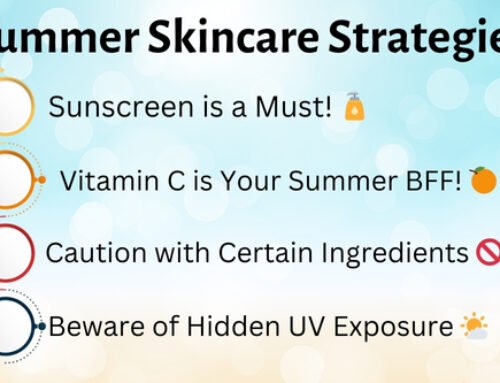In the realm skincare, Vitamin C is widely recognized and appreciated for its brightening and antiaging benefits. This potent antioxidant helps brighten the complexion and protects the skin from environmental damage, giving you a more even skin tone.
However, the multitude of Vitamin C products available can be overwhelming. From different formulations like serums and creams to varying concentrations and types of Vitamin C, the choices can be confusing. Not all Vitamin C is created equal. Different forms, such as L-ascorbic acid and tetrahexyldecyl ascorbate, have varying levels of stability, absorption, and efficacy. Understanding these differences is essential to maximizing the full potential of this skincare superstar and achieving radiant, healthy skin.
This article will outline the benefits of Vitamin C, the various formulations, and how to effectively choose and use these products.
The Benefits of Vitamin C for Skin
Antioxidant Properties
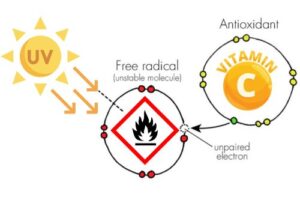
One of the primary reasons Vitamin C is so valued in skincare is its potent antioxidant properties, and ability to mitigate sun damage. Just like antioxidants are important for the body, they are also important for the skin. Free radicals are unstable molecules produced by environmental factors like UV rays, pollution, and smoking. In scienc-y terms, free radicals contain unpaired electrons which make them highly unstable and capable of causing cellular damage, leading to premature aging and other skin issues. Vitamin C donates electrons to these free radicals, neutralizing and stabilizing them, and preventing further harm to skin cells.
Brightening Effect
Vitamin C is renowned for its ability to brighten the skin and even out skin tone. It achieves this by inhibiting melanin production, which can help reduce the appearance of dark spots, hyperpigmentation, and acne scars. It specifically acts on the Tyrosinase enzyme, preventing it from creating new melanin pigment. It is considered a weak Tyrosinase inhibitor (of which there is a multitude of other products) With regular continued use, this can lead to a more radiant and uniform complexion.
Collagen Production
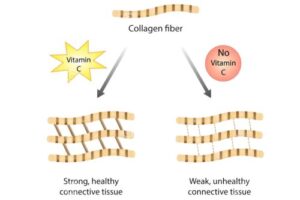
After the age of 20 the natural production of collagen decreases every year leading to loss of skin integrity, crepey skin, and wrinkles. Microneedling is one way to combat this degradation and increase collagen production, incorporating Vitamin C is another way. Collagen is a crucial protein that provides structure and elasticity to the skin. Vitamin C is a crucial component to the collagen production process. It is a necessary component for the enzymes critical for stabilizing and cross-linking collagen molecules. Without Vitamin C, your body cannot make collagen. Creating new collagen helps improve skin elasticity and reduces the appearance of fine lines and wrinkles. If you’re already incorporating microneedling in your skin care routine, be sure you’re also getting ample Vitamin C to support the collagen building process.
Different Types of Vitamin C and Their Benefits
Ascorbic Acid: the pure form of Vitamin C
As you begin reading labels, you will find a wide spectrum of types of Vitamin C. The pure form of Vitamin C is called L-Ascorbic Acid. This is the form of Vitamin C that you get from nutritional sources like kiwi, citrus fruits, bell peppers, and leafy greens. It is the form that is the most well studied, but is not the most suitable for topical skin use. LAA is water soluble, meaning it fully dissolves in water. Skin cells however, are encased in a layer of oil, so water soluble products are not easily absorbed into the skin. L-Ascorbic Acid is also very unstable and degrades rapidly when exposed to light and air, making proper storage essential for maintaining its efficacy.
Tetrahexyldecyl Ascorbate: A Stable and Oil-Soluble Vitamin C Derivative
Tetrahexyldecyl ascorbate (THDA) is considered one of the best forms of vitamin C for skin care. THDA is an oil-soluble form of vitamin C that can penetrate the deeper layers of the skin, and is less irritating compared to L Ascorbic Acid. It is a more stable form of Vitamin C which means it won’t go bad as quickly as Ascorbic Acid. This stability makes it highly effective as an antioxidant, and for collagen production and skin brightening.
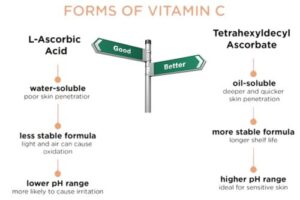
The Vitamin C Derivatives
The other forms of Vitamin C are called “the derivatives”. The derivatives of Vitamin C contain the basic Vitamin C molecule, but have been molecularly altered in a way that makes them more stable and penetrate the skin easier than the basic Ascorbic Acid form.
There are many Vitamin C derivatives: Sodium Ascorbyl Phosphate, Magnesium Ascorbyl Phosphate, Ascorbyl Tetraisopalmitate, Tetrahexyldecyl Ascorbate, Ascorbyl Glucoside, Ascorbyl palmitate, 3-O-Ethyl Ascorbic Acid, and more. Each of these derivatives have slightly different properties and may be better suited in certain formulations. This article is only discussing Ascorbic Acid, and the Tetrahexyldecyl ascorbate derivative.
Stability and Storage Considerations
One critical aspect to consider when choosing a Vitamin C product is its stability and how it should be stored to maintain efficacy. Vitamin C, especially in its pure form as L-ascorbic acid, is notoriously unstable when exposed to light and air. This instability can lead to rapid degradation, decreasing its effectiveness over time, and wasting your money. To minimize its exposure to air and light, L-ascorbic acid formulations should be packaged in airless opaque or dark-colored bottles. Airless pumps are the best options, droppers are the worst options. Fresh Ascorbic Acid should be clear or pale yellow. If the color turns dark orange or brown, the Vitamin C has gone bad.
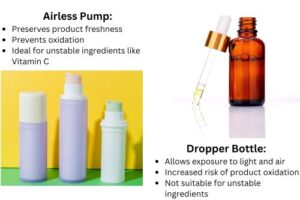
On the other hand, tetrahexyldecyl ascorbate (THDA) offers a notable advantage in terms of stability. Being oil-soluble, THDA is less prone to oxidation compared to water-soluble L-ascorbic acid. This makes THDA formulations more stable and less likely to degrade quickly, even when exposed to light and air. While it’s still beneficial to store THDA products away from direct sunlight and excessive heat, they generally have a longer shelf life and retain their potency better than L-ascorbic acid formulations.
Effective Concentrations of Vitamin C
Determining the optimal concentration of Vitamin C in skincare products is crucial for achieving desired results without causing irritation. Here’s a breakdown of the two forms of Vitamin C discussed in this article:
L-ascorbic Acid (LAA): The effectiveness of ascorbic acid serum increases with its concentration, with optimal results seen at concentrations between 10 – 20% Ascorbic acid serums containing greater than 20% are simply wasting your money. This range is known to provide robust antioxidant protection, stimulate collagen synthesis, and improve skin brightness. However, higher concentrations of ascorbic acid are also more irritating to the skin. When starting your Vitamin C journey, always start with a lower concentration, and work your way up.
Tetrahexyldecyl Ascorbate (THDA): THDA is effective at lower concentrations compared to L-ascorbic acid, generally ranging from 3% to 10%. Despite its lower concentration, THDA exhibits enhanced stability and penetration capabilities, making it gentle yet effective for antioxidant benefits, collagen support, and skin tone improvement. Lower concentrations of THDA can be well-tolerated by various skin types while still delivering significant skincare benefits.
Enhancing Vitamin C with Other Ingredients
Synergistic Ingredients
In skincare routines, Vitamin C can be a versatile ally when combined strategically with complementary ingredients. Vitamin C alone provides some photoprotection, but it works even better when paired with ingredients like ferulic acid and vitamin E. This combination not only stabilizes ascorbic acid but also enhances its antioxidant properties, providing robust protection against free radicals and environmental stressors. This study speaks specifically about the combination of 0.5% ferulic acid, 15% Vitamin C and 1% Vitamin E increasing the efficacy of Vitamin C by eight times.
Incompatible ingredients
It’s essential to note that L-ascorbic acid can be more reactive and may cause irritation when used with certain active ingredients like alpha-hydroxy acids (AHAs) or retinoids. Therefore, it’s advisable to introduce these combinations gradually and monitor skin reactions.
Understanding how these ingredients team up helps you pick skincare products that give your skin the best protection and health benefits.
Conclusion: Unlocking the Secrets to Radiant and Healthy Skin with Vitamin C
In conclusion, Vitamin C is a powerful ingredient that offers numerous benefits for the skin, from antioxidant protection to collagen synthesis and brightening effects. By understanding the different types of Vitamin C and selecting the right form for your skin type, you can unlock the secrets to achieving radiant and healthy skin. Whether you choose L-Ascorbic Acid for its potent antioxidant properties, Sodium Ascorbyl Phosphate for its gentle nature, or Tetrahexyldecyl Ascorbate for its oil-soluble benefits, incorporating Vitamin C into your skincare routine can transform your complexion and help you achieve optimal skin health.




